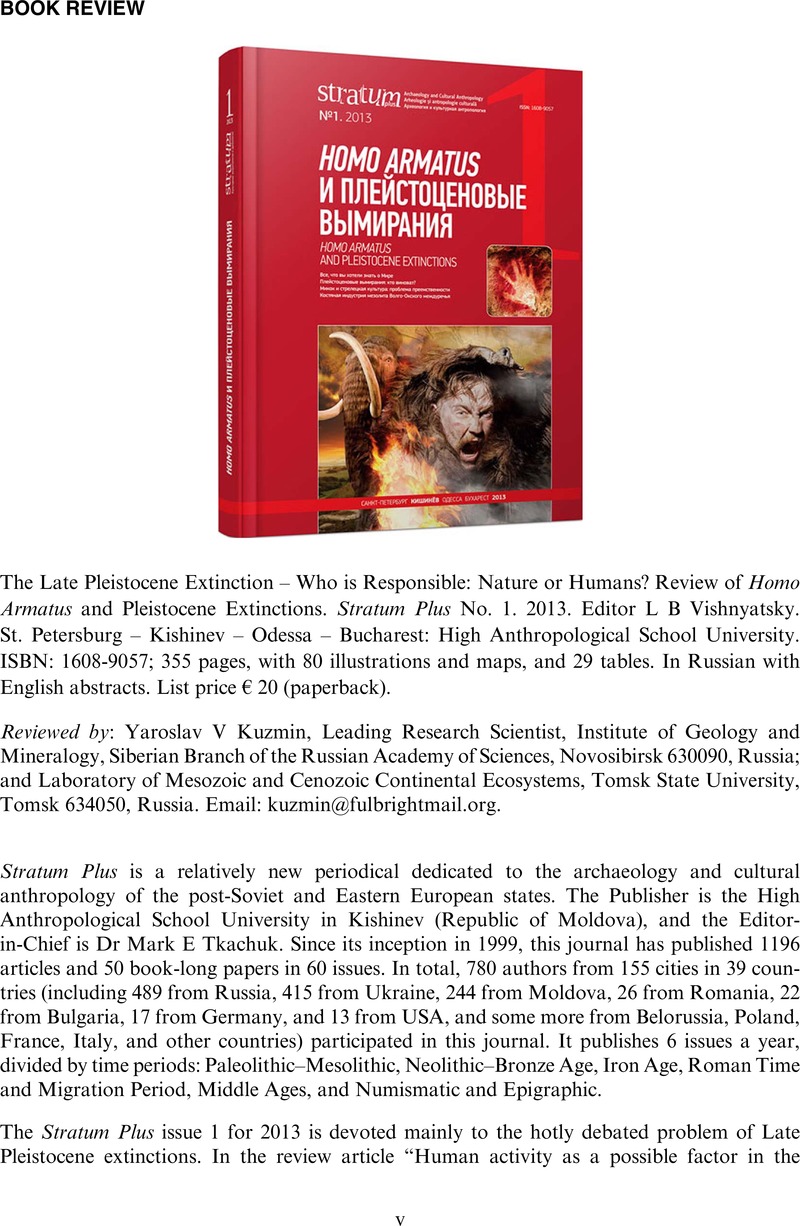No CrossRef data available.
Article contents
The Late Pleistocene Extinction – Who is Responsible: Nature or Humans? Review of Homo Armatus and Pleistocene Extinctions. Stratum Plus No. 1. 2013. Editor L B Vishnyatsky. St. Petersburg – Kishinev – Odessa – Bucharest: High Anthropological School University. ISBN: 1608-9057; 355 pages, with 80 illustrations and maps, and 29 tables. In Russian with English abstracts. List price € 20 (paperback).
Review products
The Late Pleistocene Extinction – Who is Responsible: Nature or Humans? Review of Homo Armatus and Pleistocene Extinctions. Stratum Plus No. 1. 2013. Editor L B Vishnyatsky. St. Petersburg – Kishinev – Odessa – Bucharest: High Anthropological School University. ISBN: 1608-9057; 355 pages, with 80 illustrations and maps, and 29 tables. In Russian with English abstracts. List price € 20 (paperback).
Published online by Cambridge University Press: 22 February 2016
Abstract
An abstract is not available for this content so a preview has been provided. Please use the Get access link above for information on how to access this content.

- Type
- Book Review
- Information
- Copyright
- © 2016 by the Arizona Board of Regents on behalf of the University of Arizona
References
REFERENCES
Danilkin, AA. 2009.
Dinamika Naseleniya Dikikh Kotypnykh Rossii
[Population Dynamics of the Wild Hoofed Mammals in Russia]. Moscow: KMK Press. 310 p. In Russian.Google Scholar
Dolgikh, BO. 1960.
Rodovoi i Plemennoi Sostav Narodov Sibiri v XVII-m Veke
[The Clan and Tribal Structure of the Peoples of Siberia in the 17th Century]. Moscow: Nauka Publishers. 624 p. In Russian.Google Scholar
Nikolskiy, PA, Sulerzhitsky, LD, Pitulko, VV. 2011. Last straw versus Blitzkrieg overkill: climate-driven changes in the Arctic Siberia mammoth population and the Late Pleistocene extinction problem. Quaternary Science Reviews
30(17–18):2309–2328.CrossRefGoogle Scholar
Pitulko, VV, Nikolsky, PA, Girya, EY, Basilyan, AE, Tumskoy, VE, Koulakov, SA, Astakhov, SN, Pavlova, EY, Anisimov, MA. 2004. The Yana RHS site: humans in the Arctic before the Last Glacial Maximum. Science
303(5654):52–56.Google Scholar
Puchkov, PV. 2003. The impact of mammoths in their biome: clash of two paradigms. In: Reumer J, de Vos J, Mol D, editors. Advances in Mammoth Research. Rotterdam: Natural History Museum. p 513–556.Google Scholar
Verkhovskaya, NB. 1988. Mammoth ecosystems and causes of their disappearances. Zhurnal Obshchei Biologii
49(1):70–83. In Russian with English abstract.Google Scholar




